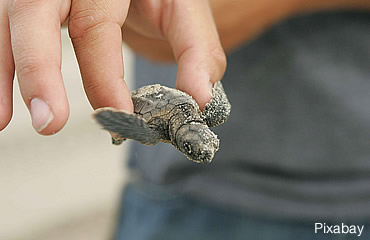Loggerhead sea turtles have crawled their way to a conservation milestone in Georgia.
By the last week in July 2016, the hard-shell giants with log-sized heads had laid more than 3,100 nests, according to the Georgia Sea Turtle Cooperative, a small army of beach-patrolling staff, interns and volunteers.
With nesting season winding down and hatching ramping up, the record total is more evidence the threatened marine turtles are doing well.
Mark Dodd, senior wildlife biologist with the DNR Nongame Conservation section, noted the 3,100-plus nests is about a third more than last year’s 2,335 nests, the previous high since comprehensive surveys began on Georgia beaches in 1989.
“When you think about the fact that for many years we averaged about 1,000 nests, this suggests an exponential increase,” according to Dodd, Sea Turtle program coordinator.
 Loggerheads are Georgia’s main nesting sea turtle. Weighing as much as 400 pounds, females crawl onto beaches from late spring until August to lay eggs in nests dug on the dry-sand beaches. Hatchlings begin emerging in July, scrambling for the surf to begin their lives at sea.
Loggerheads are Georgia’s main nesting sea turtle. Weighing as much as 400 pounds, females crawl onto beaches from late spring until August to lay eggs in nests dug on the dry-sand beaches. Hatchlings begin emerging in July, scrambling for the surf to begin their lives at sea.
Threats to sea turtles range from habitat loss to nest predation, boat strikes and incidental catch in commercial fishing. All have reduced loggerhead numbers, leading to legal protections and conservation efforts.
Loggerheads are listed as threatened under the Endangered Species Act.
Dodd cautions that the recovery of loggerheads “still has a long way to go.” He stressed the need for continued conservation, and emphasized the partnerships forged from grassroots groups to government agencies to monitor nesting, restore habitats and protect sea turtles.
He also said the health of the iconic turtles effects coastal environments and economies.
“Our goal is to recover loggerheads in the state and make sure the population is stable,” Dodd said. At 3,100 nests and counting, “we’re reaching one of the milestones set to achieve that.”
If you’re on a beach in Georgia . . .
Visitors to Georgia beaches should know that all marine turtles in Georgia are protected by state and federal law.
 To help conserve these species, when walking the beach at night during nesting season, don’t use flashlights and flash photography, which can deter turtles from coming ashore or disturb nesting turtles. Turn off, shield or redirect lights.
To help conserve these species, when walking the beach at night during nesting season, don’t use flashlights and flash photography, which can deter turtles from coming ashore or disturb nesting turtles. Turn off, shield or redirect lights.
If you encounter a sea turtle on the beach, observe at a distance. Never touch or disturb nests or hatchlings, and don’t disturb turtle tracks. Researchers use them to identify species and mark nests for protection.
Always properly dispose of your garbage because turtles can mistake plastic bags, Styrofoam and trash floating in the water as food.
Not only are loggerheads are the most common sea turtle on Georgia’s coast, and are found off coast year-round, they are also one of the world’s largest turtles, topping 350 pounds and sporting a carapace, their hard shell, up to 44 inches long.
How long loggerheads live is not known, but it’s easy to see how their name refers to the species’ large head.
Loggerheads are found in the Atlantic, Pacific and Indian oceans, and the Mediterranean Sea. In the U.S., their nests are found on shorelines from Virginia to Texas. Females crawl ashore at night from May through September, dig a hole in the face of dunes along barrier island beaches, and deposit and cover eggs. Turtle eggs hatch in 55-65 days and the new turtles move back to the water.
For more information on loggerhead turtles, visit http://www.seaturtle.org/nestdb/?view=3 or
http://www.georgiawildlife.com/rarereptiles.
— Courtesy Georgia Department of Natural Resources